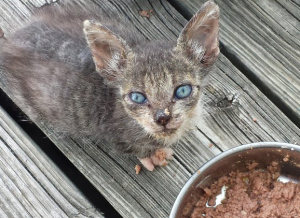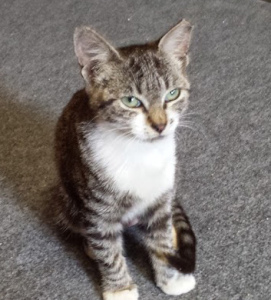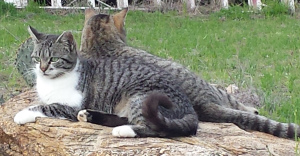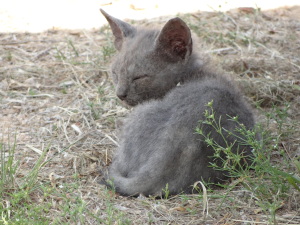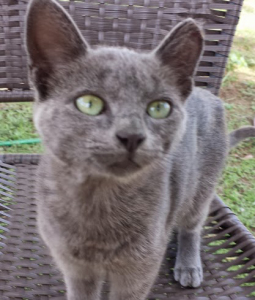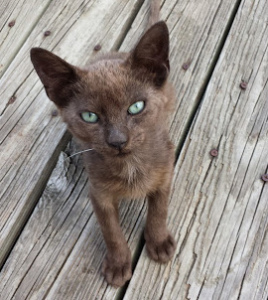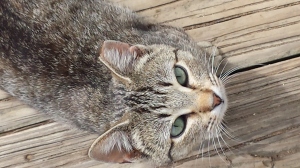One year ago, I had a few feral cats hanging around my property. I “inherited” feral cats when I moved into my home, but I made the mistake of not having enough knowledge or foresight to do a trap, neuter, release program with them. I have my own indoor pets and I fed the outdoor cats to help them, but that was the extent of my knowledge and care.
Boy have I learned a lot since then.
First, if you don’t know what a feral cat is, let me explain. To many, “feral” denotes savage and uncontrolled creatures, but that is not true. A feral cat is an untamed, undomesticated cat that prefers to be outside away from humans. Doesn’t mean it won’t eventually learn to trust humans and it doesn’t mean it is aggressive or full of disease. What it does mean is that it doesn’t trust you and likely will always have fear. Which is probably best, because there’s a lot out there for them to fear. Feral cats are often scared, but can still make good pets. I have made feral cats into pets.
Many people believe that killing feral cats is the best way to deal with them but what they don’t realize is if you kill one, more will take its place. Cats are territorial and will rarely let other cats in, unless they are gone. So if you kill one, more will take its place. What’s the point in that?
Last year, this particular cat I speak of had babies. She was incredibly wild but we were working on getting her to trust us. Before we got her close enough to us, she ended up dying, I’m pretty sure because my neighbors shot it with a BB gun. Unfortunately, that BB eventually killed her (yes, BBs can kill, although not always right away!) This cat had kittens, and I was able to rescue them. Soon, I had them tame and on an eating schedule. They were a little messed up, their hair matted, ringworms all over their body.
That word is enough to scare anyone, but it didn’t scare me. I did my research and know that most healthy cats can get rid of the fungus and yes, you can get rid of it around your property, too. So I bought lime sulfur dip, and the results were almost immediate. Soon, the kittens were growing back their hair and were the cutest, softest, cuddliest babies I’ve ever known.
I did get ringworms, I will admit. That’s because it was the springtime and I thought I had mosquitoes. I put cortisone on it, the worst thing you can do for fungal infections! It looked worse than it was, but I lived through it none the worse for wear.
It isn’t okay to kill nuisances. I know most people would have done that, but I am not most people.
Because I intended to spay/neuter the cats and release them back into the property and care for them, I took them to my local humane society to be fixed. I was nervous and scared of what would happen to these animals since I’ve never done this before. I had bonded with, but I’ve never been so impressed with a facility as I was with The Austin Humane Society. Walking in, I saw many animals for the TNR program, some from a company who helps people and some from people like me who were trying to help the world.
The humane society had other cats they allowed you to visit while you waited, and I felt so sad for these animals. Yet, these animals weren’t exactly abandoned. They had a home in a no-kill shelter, given free time to play and be petted. I blinked back tears as I checked in so no one would think I was crazy, but I cried. Some of the cats lost their parents and were relinquished. Some might never be adopted out. And the effort of the humane society, the love these people felt, the good they were doing with their jobs, made me realize there is still good left in this world.
Next time you see a cat with an ear-tip, leave it. It was part of the trap, neuter, release program and is fixed, released back into the wild, where it will make its home. Don’t consider it a nuisance because killing it will only bring in more animals. And if it isn’t fixed, consider trapping it or calling someone to find out if there’s a local trap, neuter, release program nearby. For more information about ear tipping, go here http://www.feralcatproject.org/faq.aspx
My dad, being the cautious dad he is, lectures me on rabies. TNR programs also do rabies shots, and now the cats are tame enough I can give them their updated shots. I’m still working on helping the other neighborhood cats get fixed, and am still feeding the wild ones that won’t get close enough for me to tame. Call me a crazy cat lady, but I love what I do and love helping these animals!
So that’s my experience. If you want to know more about trapping and releasing animals, feel free to ask. Curious about ringworms and how to safely help them? Lemme know and I’ll be glad to give you info. I promise it isn’t as bad as it sounds.

